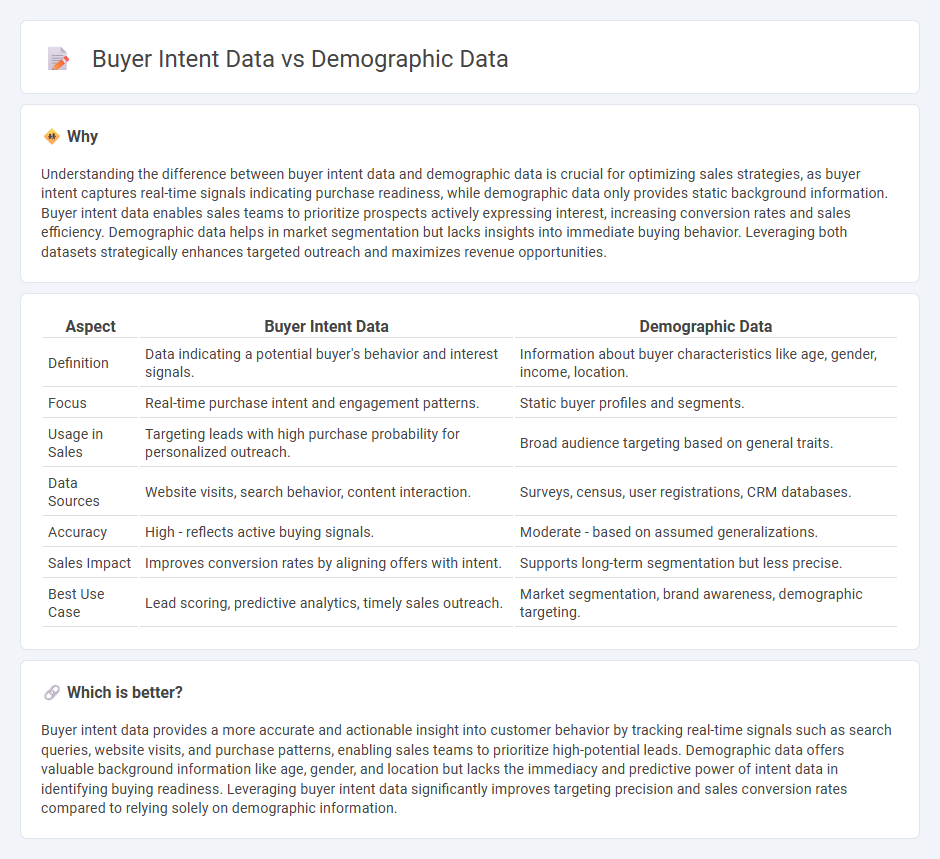
Buyer intent data provides real-time insights into a customer's purchasing signals by analyzing online behavior and content engagement, enabling highly targeted sales strategies. Demographic data offers foundational information about consumers such as age, gender, location, and income, which helps in segmenting markets for broad campaigns. Explore how integrating buyer intent data with demographic profiles can dramatically enhance sales effectiveness and lead generation.
Why it is important
Understanding the difference between buyer intent data and demographic data is crucial for optimizing sales strategies, as buyer intent captures real-time signals indicating purchase readiness, while demographic data only provides static background information. Buyer intent data enables sales teams to prioritize prospects actively expressing interest, increasing conversion rates and sales efficiency. Demographic data helps in market segmentation but lacks insights into immediate buying behavior. Leveraging both datasets strategically enhances targeted outreach and maximizes revenue opportunities.
Comparison Table
| Aspect | Buyer Intent Data | Demographic Data |
|---|---|---|
| Definition | Data indicating a potential buyer's behavior and interest signals. | Information about buyer characteristics like age, gender, income, location. |
| Focus | Real-time purchase intent and engagement patterns. | Static buyer profiles and segments. |
| Usage in Sales | Targeting leads with high purchase probability for personalized outreach. | Broad audience targeting based on general traits. |
| Data Sources | Website visits, search behavior, content interaction. | Surveys, census, user registrations, CRM databases. |
| Accuracy | High - reflects active buying signals. | Moderate - based on assumed generalizations. |
| Sales Impact | Improves conversion rates by aligning offers with intent. | Supports long-term segmentation but less precise. |
| Best Use Case | Lead scoring, predictive analytics, timely sales outreach. | Market segmentation, brand awareness, demographic targeting. |
Which is better?
Buyer intent data provides a more accurate and actionable insight into customer behavior by tracking real-time signals such as search queries, website visits, and purchase patterns, enabling sales teams to prioritize high-potential leads. Demographic data offers valuable background information like age, gender, and location but lacks the immediacy and predictive power of intent data in identifying buying readiness. Leveraging buyer intent data significantly improves targeting precision and sales conversion rates compared to relying solely on demographic information.
Connection
Buyer intent data reveals the signals and behaviors indicating a prospect's readiness to purchase, while demographic data provides insights into their age, location, gender, and income level. Combining these data sets enhances sales targeting by identifying high-potential leads within specific market segments. This connection allows sales teams to tailor messaging and prioritize outreach for improved conversion rates and revenue growth.
Key Terms
**Demographic Data:**
Demographic data includes age, gender, income, education level, and geographic location, providing a foundational profile of target audiences. This data helps businesses segment markets and tailor marketing strategies to specific consumer groups. Discover how leveraging demographic data can enhance your customer targeting and drive better marketing outcomes.
Age
Demographic data categorizes buyers by age groups, such as millennials or baby boomers, providing basic information about potential customers. Buyer intent data reveals the behavior and signals indicating a person's readiness to purchase within a specific age segment, offering deeper insights into their current interests and needs. Explore how integrating both data types can enhance targeted marketing strategies.
Gender
Demographic data categorizes consumers based on gender, highlighting general trends such as purchasing preferences and product engagement among men or women. Buyer intent data goes deeper by analyzing specific online behaviors, such as search queries and content interaction, to reveal gender-specific intent signals that predict purchasing decisions. Explore how integrating both data types can enhance targeted marketing strategies and boost conversion rates.
Source and External Links
What you can learn about your community from demographics - Demographic data includes information on population size, growth, distribution, and social, economic, and housing characteristics such as age, gender, race/ethnicity, income, and housing status, useful for community planning and policy development.
Demography - Demography studies population processes and characteristics, including patient demographics like age and ethnicity, and labor market demographics which impact economic trends and workforce dynamics.
What Are Demographics? (Definition and Examples) - Demographics refer to population characteristics such as age, income, education, and geographic location, and are used by businesses and governments to develop marketing strategies and public policies.
 dowidth.com
dowidth.com